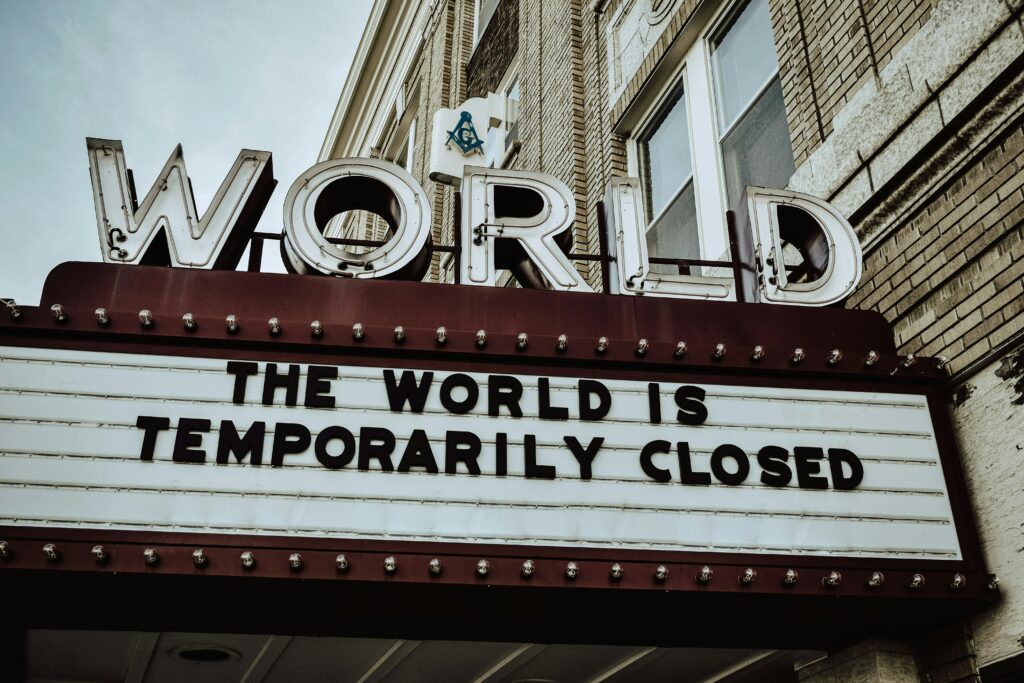In light of recent world events, thinking about monsters almost inevitably leads one to ideas of disease and contagion. The monsters swirling around the Covid-19 are many, depending on your ideological view of the pandemic and where you are in the world — with geographical location being perhaps slightly less important than your economic one. The manifestation of the monstrosity of the virus can take the form of governmental inaction and/or ignorance, the face of those not wearing a mask or social distancing, or even the neo-liberalist supply and demand system itself. Indeed, it would seem in a pandemic there are too many monsters, too many faces that stare back at us and reflect our anxieties, or seem to embody the very danger of the virus.
We are still too close to the current outbreak for there to have been many artistic cultural expressions created in direct regard to it, but that does not mean that there are not earlier films that manage to touch on and express many of the societal and individual concerns that have arisen from it. Films such as Outbreak (Petersen: 1995) and Contagion (Soderbergh: 2011) would seem obvious choices, and unsurprisingly the latter film has seen a huge spike in popularity in recent months.
But these films often contain extraneous narrative points to create dramatic thrust that can obfuscate the realities of real-world pandemics. Contagion, in particular, promotes an over-importance on the elusive “patient zero” by attributing judgement and retribution on a philandering wife and mother, Beth Emhoff, and blame on a self-styled false prophet, Adam Krumwiede (Jude Law), who denies the virus, as opposed to the system that promotes and facilitates what he does. Similarly, there have been two subsequent films called Patient Zero — one by Bryan T. Jaynes (2012) and one by Stefan Ruzowitzky (2018) — and Cabin Fever 3: Patient Zero (Andrews: 2014), alongside various television series of the same name, that focus on this issue.

In fact, human anxieties connected to contagion, such as the unseen dangers from strangers and even those we love, have long been part of the Horror genre, in general, and the construction of its monsters, in particular. It is worth considering a wider range of examples that pick up on some central concerns around the Covid-19 outbreak and seeing what kinds of “faces” they propose for the monster of contagion. These features are not necessarily part of the virus’ “own story” as such, as with many monsters it does not get to speak for itself; rather, it is the narrative placed upon it by the communities trying to control, explain, and eradicate it.
At least for Western culture, the virus is seen as an invader from the East and in a curious way subliminally linked with the idea of the War on Terror, envisioning a kind of ideological weapon released on world. This equally explains much of the language around “war”, “battle”, “siege”, etc. that surrounds the reporting of the virus’ spread. Connected to this is the idea of “patient zero”, but here it is not just about the point of origin in the East, but in each country or community where the disease is found. The infected person becomes a monster that is perhaps unknowingly a carrier of the virus, keeping his or her presence a secret until others have been infected. Alongside this is the contagion’s invisibility, which means it is simultaneously everywhere and nowhere, creating a constant anxiety around where and how one might get infected: from another person, touching a surface, or inhaling a stranger’s breath. This anxiety can only be relieved by covering one’s face or protecting oneself from the outside world, which then leads on to isolation and confinement.

The last important trope is disinformation, or the dissemination of willfully wrong and contrary information. One might almost assign this to the immune system of the virus itself in that it infects the “body” of the community by convincing it that the virus, or the danger it presents, does not exist.

There is certainly much here that resonates with vampire narratives: a contagion from the East, and which arrives in secret; the infected do not look different yet are carriers of the contagion and infect others; misinformation and hysteria accompany the burgeoning contagion spread by “agents” of the disease. Vampires like Renfield (Dwight Frye) in Dracula (Browning: 1931) and Knock (Alexander Granach) in Nosferatu (Murnau: 1922) seem to embody the virus as we know it. Nosferatu, in particular, shows death arriving with the vampire, spreading uncontrolled through the town, a silent almost invisible presence, just like the vampire’s shadow that can travel and enter in wherever it likes. In contrast, Dracula can only enter where he is invited in, and wearing special accoutrements can keep him at bay.

Richard Matheson’s I Am Legend (1954) even more obviously plays on the idea of contagion, where a mysterious dust cloud blows around the globe, infecting everyone with an unknown disease. Some, with the help of medication, are able to survive, if not totally destroy the contagion, and move into an uncertain future. Matheson’s novel has been linked to the rise of the zombie apocalypse as envisioned by George Romero first scene in Night of the Living Dead (1968). In its many subsequent permutations, it often mirrors the spread of a virus, moving across populations, borders and continents. Whilst the zombie apocalypse represents a rather extreme scenario given the fortunately lower than expected mortality rate of Covid-19, the sense of anxiety and fear aroused in communities where the outbreak is heading towards is very real. World War Z, both novel (Brooks 2006) and film (Forster: 2013), capture the panic of the approaching and unstoppable contagion that either gently seeps into a population or breaks like a tremendous wave across its borders — interestingly, Brooks’ novel sees the outbreak originating in China due to the incursion of man into nature.

Something similar is seen in The Girl With All the Gifts where humanity becomes infected with a fungus. The fungus is shown as a variant of one that ordinarily only occurs in the South America rainforest and “zombifies” ants to spread its spores, but equally suggests that mankind has incurred into territory that should be left alone. As with Matheson’s novel, the effects upon the human population are catastrophic but similarly suggest that there is the hope of a new kind of society once the original contagion has receded.
The Strain (2014–17) by Guillermo del Toro and Chuck Hogan more directly focuses on the nature of the world that the current pandemic has so expertly taken advantage of. The original trilogy of novels (2009–11) by the same authors, from which the television series is taken, made much of the Master Vampire’s exploitation of consumerism and white corporate America in its bid to infect the world. However, by the time the series began in 2014, the rise of populism was already being felt and, by its conclusion, it can be seen to be directly criticizing the ideology behind Donald Trump’s administration.

The contagion here arrives in America by plane, a major contributor to the spread of the recent pandemic, and sees the asymptotic infected being released back into the wider community of New York where the contagion then runs riot. The Master Vampire in control of this outbreak has taken advantage of corporate America — largely through the figure of Eldritch Palmer, who literally embodies white privilege and wealth — and its integration into every part of human life, so that his contagion has an open invitation into the heart of the city and the nation. They have control over the communications networks and media outlets, allowing them to misdirect the people with “fake” news as the disease spreads further and wider across the community. Once the contagion has taken hold, the uninfected become cowed in their anxiety and fear of those infected (the vampires), meaning that they prefer staying isolated in the safety of their own homes.

Curiously the series ends with the world returning quickly to normal after the source of the contagion is destroyed — in the novels, the world is forever changed by it — however, the infection lays dormant, waiting to be re-energized at some unknown point in the future.
As such, The Strain captures much of the details around the edges of contagion and the ideological background that facilitates the disease’s entry and unchecked spread through society. What it fails to capture fully is the facelessness and ambiguity of the monster at the heart of the current Covid-19 outbreak: it probably was not manufactured, it possibly started in bats, it most likely came from a wet-market in Wuhan. Although the Master Vampire is actually more of a “soul” that travels between hosts, it is the various hosts’ faces, in their vampiric similarity — hairless, bloodless, ghostly white with pointed ears — that solidify it and give it form.
A film that escapes such explicitness and captures something more visceral about the Covid-19 pandemic is the film of Bird Box (Bier: 2019) based on the 2014 novel by Josh Malerman. As with many of the examples mentioned above, the unknown contagion spreads from the East — early reports suggesting Siberia in Russia — so that we see the main protagonist in the film, Malorie (Sandra Bullock), is with her sister Jessica (Sarah Paulson), watching reports on television about a mysterious disease in Europe in the morning and, by the afternoon, the pandemic has hit the city where they live and it has descended into panic and confusion.

People quite literally lose who they are and begin acting hysterically, lost within themselves and literally dead to the outside world. The only refuge is total isolation indoors and reducing any contact with the outside world to an absolute minimum. Indeed, the anxiety created around leaving the house, or letting anyone or anything in, reflects the kinds of extreme emotional states that typify many individual experiences around the recent coronavirus outbreak. Malorie shares the house with a few others and each of them describes a different face to the contagion with no two stories sounding the same, other than they risked their very lives in being “seen” by the unseeable virus.

However, others seem to revel in the dangers presented by the pandemic, trying to encourage others to embrace its deadly ramifications. One such person enters the house: Gary (Tom Hollander) has no signs of contagion (asymptomatic) until he begins drawing images of what he has “seen”, and every picture shows a different monsters, suggesting the pandemic does not just have a thousand faces but an entirely different manifestation for each of them. It is not so much invisible but so infinite to be beyond our comprehension.

The presence of the contaminated stranger destroys the isolated safety of the home, forcing Malorie to leave with Tom (Trevante Rhodes) and two babies that she refuses to name other than “Girl” and “Boy”. Five years pass and Tom is killed, forcing Malorie and the children to move on and take to the river. However, to ensure the safety of herself and the children, they all have to wear protection over their faces to stop the contagion entering their bodies. As they travel there are constant shouts and distractions encouraging her to remove her face covering, but she resists. After many hours on the river and a long trek through woodlands she finally reaches sanctuary. Once there she uncovers her face and names the children — Olympia and Tom — knowing this new place is safe from the contagion, envisioning it as a future that this disease will never be able to touch and she will never need to see any of the faces of the monster again.
In a sense, then, many of the contagion narratives here are not so much about how humanity deals with the outbreak, but what changes it leaves in its wake. As seen with recent events in relation to Covid-19, many envision a radically different future, or a “new now,” as seen in Bird Box, Girl With All the Gifts, or the novel of World War Z, where it ushers in a redistribution wealth and influence around the world. In these the “work” of the contagion is complete, its power spent signaling a time when whoever is left can rebuild an environment beyond the ideologies that unleashed and/or invited the disease to begin with. More troubling are narratives such as the film of World War Z, and the television series The Strain, as here the world returns to what it was almost immediately. No lessons have been learned and no change in behaviour or lifestyle is required: the same environment that created the outbreak is recreated, regardless of the inevitability of the outcome. The future becomes one of waiting for the undead monsters of contagion to raise again.
Simon Bacon, editor of Monsters: A Companion

 de
de  fr
fr 









